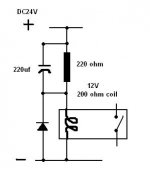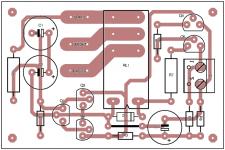Sure, but it will need to dissipate more than L versions handle and is just a more complex and expensive resistor needing additional parts in this role.
Last edited:
One comment: Fairly standard practice is to run the protection circuit directly from the transformer to its own rectifiers and diodes with a smaller filter cap and appropriate dropping resistor. This allows it to drop out as soon as power is removed, rather than waiting for supply to drop down. Would only add two diodes and capacitor (typical is 50 to 100uf) to supply power to the circuit, but add resistance based on coil resistance ad voltage. My 2 cents.
This is an easy solution to an easy circuit. I have run 5V relays from 12V sources plenty of times. I also like to slightly under-volt my relays to keep them living longer.
First thing to do is measure the DC resistance of the relay coil, to help you determine your resistor value needed! Since in your case you need half the supply voltage, use a resistor that closely matches your relay coil, to functionally divide the voltage. Slightly higher resistor is good if you want to run the relay cooler.
A method I like to use is a series resistor with a 220uf capacitor in parallel with it. This allows the relay to get a stronger magnetizing current at startup, then once the capacitor charges, the voltage drops across the resistor to run the relay at the desired lower value.
First thing to do is measure the DC resistance of the relay coil, to help you determine your resistor value needed! Since in your case you need half the supply voltage, use a resistor that closely matches your relay coil, to functionally divide the voltage. Slightly higher resistor is good if you want to run the relay cooler.
A method I like to use is a series resistor with a 220uf capacitor in parallel with it. This allows the relay to get a stronger magnetizing current at startup, then once the capacitor charges, the voltage drops across the resistor to run the relay at the desired lower value.
Attachments
Thank you all for your answers.
I have another question.
The solution with the series resistor works well but imagining that my power supply is 30v of example and not of 24v, will it be necessary to adjust other parts of the circuit or only the value of this resistance?
Regards!
I have another question.
The solution with the series resistor works well but imagining that my power supply is 30v of example and not of 24v, will it be necessary to adjust other parts of the circuit or only the value of this resistance?
Regards!
Make sure the voltage of the "startup" capacitor is higher than your power supply voltage.
Use a 35V or 50V part in this case.
Use a 35V or 50V part in this case.
Well, it's quite the opposite.I also like to slightly under-volt my relays to keep them living longer.
What kills relays is not "worn coils" or something (never saw that 😕 ) but pitted contacts.
Applying *less* pressure than designed worsens contact and helps faster pitting.
Just sayin'.
Well, it's quite the opposite.
What kills relays is not "worn coils" or something (never saw that 😕 ) but pitted contacts.
Applying *less* pressure than designed worsens contact and helps faster pitting.
Just sayin'.
The Startup capacitor provides the high pressure required to lock in the relay. Once it has closed, the holding current can be somewhat less and keep good contact.
- Status
- Not open for further replies.
- Home
- Amplifiers
- Solid State
- relay coil that heats.

